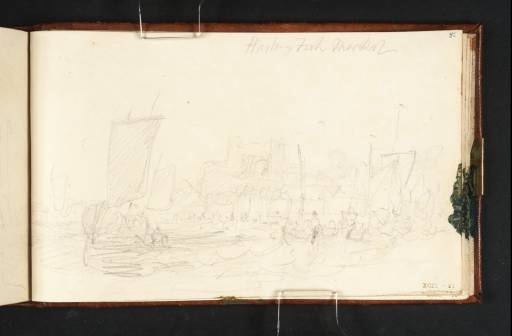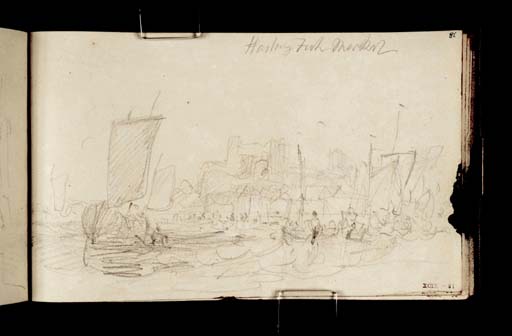Joseph Mallord William Turner Hastings Fish Market c.1805-9
Image 1 of 2
Joseph Mallord William Turner,
Hastings Fish Market
c.1805-9
Joseph Mallord William Turner 1775–1851
Folio 85 Recto:
Hastings Fish Market circa 1805–9
D06501
Turner Bequest XCIX 81
Turner Bequest XCIX 81
Pencil on off-white wove paper, 115 x 190 mm
Inscribed by Turner in pencil ‘Hastings Fish Market’ top centre
Inscribed by John Ruskin in blue ink ‘81’ top right
Stamped in black ‘XCIX 81’ bottom right
Inscribed by Turner in pencil ‘Hastings Fish Market’ top centre
Inscribed by John Ruskin in blue ink ‘81’ top right
Stamped in black ‘XCIX 81’ bottom right
Accepted by the nation as part of the Turner Bequest 1856
References
1909
A.J. Finberg, A Complete Inventory of the Drawings of the Turner Bequest, London 1909, vol.I, p.259, XCIX 81.
1974
Gerald Wilkinson, The Sketches of Turner, R.A. 1802–20: Genius of the Romantic, London 1974, p.87 reproduced.
This subject appears out of place in this sketchbook, otherwise devoted to the Rivers Thames and Medway. Turner did draw a ‘Hastings Herring Boat’ on folio 68 verso (D06470; Turner Bequest XCIX 64a), but that leaf is otherwise occupied by a view of Sheerness and Turner need not have studied the vessel in its home waters but elsewhere along the coast as it brought fish to sell elsewhere. He included a Hastings boat in the foreground of his picture Margate of 1808 (Tate T03876; displayed at Petworth House)1 where it is hailed by local fishermen. Like another anomaly in this sketchbook, a drawing seemingly of Walton Bridges (folio 75 recto: D06483; Turner Bequest XCIX 71), the study is more developed, with hatching and shading, than most of the sketches in the book and was perhaps not made on the spot. If it was, Turner must have extended a trip from the mouth of the Thames and round the Kent and Sussex coast, or taken the sketchbook with him on a different occasion.
The popularity of Hastings as a picturesque subject took off in 1808 when Joshua Cristall exhibited a large watercolour of the fish market (Victoria and Albert Museum, London) at the Water Colour Society and prompted ‘a Host of Artists ... to go to Hastings’ as reported by Joseph Farington.2 Thomas Heaphy showed his own watercolour of Hastings (private collection) the following year and sold it for a record 400 guineas. The old fishing port was already being developed as a resort for sea-bathing but its pictorial appeal rested mainly on historical and topographical factors. William the Conqueror had landed nearby in 1066; later, fishermen from this and other Cinque Ports had provided what was effectively England’s first navy and had won special liberties for their communities. Visually, the town was distinctive, for as there was no harbour the fishermen brought their luggers up to the beach, the ‘Stade’, where they sold their catch. It was backed by steep cliffs and housed the cluster of old wooden net stores that survives today.
These are clearly seen in Turner’s drawing but are absent from the picture of a ‘Fish Market’ that Turner exhibited at his Gallery in 1810 and sold to his Sussex patron John Fuller (William Rockhill Nelson Gallery and Atkins Museum of Fine Arts, Kansas City, Missouri).3 This picture was known as ‘Hastings’ by 1862, and Butlin and Joll suggest that Turner may have told Fuller that his scene was set there to increase its appeal. However, they also record that Eric Shanes had questioned the identification and to the present writer it seems inconceivable that Turner would paint a picture of Hastings in 1810 that so far turns its back on the distinctive features of the place and has no connection with his own drawing made several years earlier or indeed with the recent watercolours by Cristall and Heaphy. Turner’s watercolour Fish Market at Hastings (Hastings Museum and Art Gallery)4 painted in 1824, while idiosyncratic in its inclusion of two Greeks as a reference to the Greek War of Independence in progress at the time, nevertheless adopts a conventional viewpoint along the Stade with the net stores and cliffs.
David Blayney Brown
March 2009
Martin Butlin and Evelyn Joll, The Paintings of J.M.W. Turner, revised ed., new Haven and London 1984, pp.59–60 no.78 (pl.88).
How to cite
David Blayney Brown, ‘Hastings Fish Market c.1805–9 by Joseph Mallord William Turner’, catalogue entry, March 2009, in David Blayney Brown (ed.), J.M.W. Turner: Sketchbooks, Drawings and Watercolours, Tate Research Publication, December 2012, https://www


